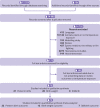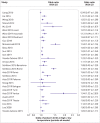Associations between high temperatures in pregnancy and risk of preterm birth, low birth weight, and stillbirths: systematic review and meta-analysis
- PMID: 33148618
- PMCID: PMC7610201
- DOI: 10.1136/bmj.m3811
Associations between high temperatures in pregnancy and risk of preterm birth, low birth weight, and stillbirths: systematic review and meta-analysis
Abstract
Objective: To assess whether exposure to high temperatures in pregnancy is associated with increased risk for preterm birth, low birth weight, and stillbirth.
Design: Systematic review and random effects meta-analysis.
Data sources: Medline and Web of Science searched up to September 2018, updated in August 2019.
Eligibility criteria for selecting studies: Clinical studies on associations between high environmental temperatures, and preterm birth, birth weight, and stillbirths.
Results: 14 880 records and 175 full text articles were screened. 70 studies were included, set in 27 countries, seven of which were countries with low or middle income. In 40 of 47 studies, preterm births were more common at higher than lower temperatures. Exposures were classified as heatwaves, 1°C increments, and temperature threshold cutoff points. In random effects meta-analysis, odds of a preterm birth rose 1.05-fold (95% confidence interval 1.03 to 1.07) per 1°C increase in temperature and 1.16-fold (1.10 to 1.23) during heatwaves. Higher temperature was associated with reduced birth weight in 18 of 28 studies, with considerable statistical heterogeneity. Eight studies on stillbirths all showed associations between temperature and stillbirth, with stillbirths increasing 1.05-fold (1.01 to 1.08) per 1°C rise in temperature. Associations between temperature and outcomes were largest among women in lower socioeconomic groups and at age extremes. The multiple temperature metrics and lag analyses limited comparison between studies and settings.
Conclusions: Although summary effect sizes are relatively small, heat exposures are common and the outcomes are important determinants of population health. Linkages between socioeconomic status and study outcomes suggest that risks might be largest in low and middle income countries. Temperature rises with global warming could have major implications for child health.
Systematic review registration: PROSPERO CRD 42019140136 and CRD 42018118113.
© Author(s) (or their employer(s)) 2019. Re-use permitted under CC BY-NC. No commercial re-use. See rights and permissions. Published by BMJ.
Conflict of interest statement
Competing interests: All authors have completed the ICMJE uniform disclosure form at www.icmje.org/coi_disclosure.pdf and declare: support from NERC, RCN, and Forte in collaboration with Vetenskapsrådet, coordinated through a Belmont Forum partnership, for the submitted work. MFC and FS hold investments in the fossil fuel industry through their pension funds. The University of the Witwatersrand holds investments in the fossil fuel industry through their endowments and other financial reserves. AM is a member of the Global Change Institute, University of the Witwatersrand, where part of the administrative support is funded by Exxaro, which has interests in coal mining and renewable energy. MR has a pension fund with Irish Life, which includes investments in fossil fuel companies.
Figures






References
-
- Intergovernmental Panel on Climate Change. Special report on global warming of 1.5°C. https://www.ipcc.ch/sr15/. 2018.
-
- United Nations. Framework Convention on Climate Change. Subsidiary Body for Scientific and Technological Advice. 46th session. Nairobi work programme on impacts, vulnerability and adaptation to climate change. Human health and adaptation: understanding climate impacts on health and opportunities for action. 2017. https://unfccc.int/sites/default/files/resource/docs/2017/sbsta/eng/02.pdf
-
- USAID. Heat waves and human health: emerging evidence and experience to inform risk management in a warming world. 2019. https://www.climatelinks.org/sites/default/files/asset/document/2019_USA....
Publication types
MeSH terms
LinkOut - more resources
Full Text Sources
Medical
